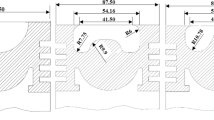Abstract
Geometrical features of combustion chamber are important factors in subsequent engine’s combustion and emissions. Control over combustion that is difficult to attain due to the complexity of the processes involved is the key objective in designing the combustion chamber. Reduction of engine emissions and fuel consumption can be reached by an improved control over the degree of homogeneity of the air–fuel mixture, cycle-to-cycle variation, and turbulence intensity. The CFD simulation to investigate the effect of piston bowl of a four-stroke direct injection compression ignition engine under the operating condition is presented. The analyses are dedicated to investigate the outcome of the piston shape differences to the fluid flow and turbulence characteristics for air–fuel mixture preparation in terms of turbulence kinetic energy. The numerical calculations were performed in a single cylinder direct injection compression ignition engine running at wide open throttle condition by using the CFD code. Two different piston bowls for certain engine speeds were considered to compare and evaluate the mentioned parameters produced during intake and compression stroke. The results obtained from the numerical analysis can be employed to examine the homogeneity of air–fuel mixture configuration for better combustion process and engine performance.
Access this chapter
Tax calculation will be finalised at checkout
Purchases are for personal use only
Similar content being viewed by others
References
Sanaev NK, Makhin AV, Sal’nitskii FA (2009) CAD systems in the production of diesel-engine pistons with a complex combustion chamber. Russ Engin Res 29:1089. http://doi.org/10.3103/S1068798X09110057
Fettes C, Schulze T, Leipertz A et al (2002) Combustion chamber wall influences on the vaporisation mixture formation and combustion in DI diesel engines with a small combustion chamber. MTZ Worldw 63:26–30. https://doi.org/10.1007/BF03227569
Yadav P, Saravanan CG, Edward J, Perumal R (2015) Experimental and numerical investigation of flow and combustion in a DI diesel engine with different piston geometries. SAE technical paper 2015-01-0378. http://doi.org/10.4271/2015-01-0378
Miles PC (2000) The influence of swirl on HSDI diesel combustion at moderate speed and load. SAE technical papers 2000-01-1829. http://doi.org/10.4271/2000-01-1829
Kook S, Bae C, Miles P, Choi D, Bergin M, Reitz R (2006) The effect of swirl ratio and fuel injection parameters on CO emission and fuel conversion efficiency for high dilution low temperature combustion in an automotive diesel engine. SAE Paper 2006-01-0197. https://doi.org/10.4271/2006-01-0197
Prasad BVVSU, Sharma CS, Anand TNC, Ravikrishna RV (2011) High swirl-inducing piston bowls in small diesel engines for emission reduction. Appl Energy 88:2355–2367. https://doi.org/10.1016/j.apenergy.2010.12.068
Heywood JB (1988) Internal combustion engine fundamentals. McGraw-Hill, New York
Prabhakaran P, Ramesh P, Saravanan CG, Loganathan M, James GE (2016) Experimental and numerical investigation of a swirl enhancing grooves on the flow and combustion characteristics of a DI diesel engine. Energy 115:1234–1245. https://doi.org/10.1016/j.energy.2016.09.063
Lv J, Bai M, Zhou L et al (2010) Effect of heat transfer space non-uniformity of combustion chamber components on in-cylinder heat transfer in diesel engine. Front Energy Power Eng China 4:392–401. https://doi.org/10.1007/s11708-009-0066-1
Taghavifar H, Khalilarya, Jafarmadar S (2014) Engine structure modifications effect on the flow behavior combustion and performance characteristics of DI diesel engine. Energy Convers Manage 85:20–32. https://doi.org/10.1016/j.enconman.2014.05.076
Choi GH, Lee JC, Kwon TY et al (2009) Combustion characteristics of a swirl chamber type diesel engine. J Mech Sci Technol 23:3385–3392. https://doi.org/10.1007/s12206-009-1011-2
Gureev VM, Khairullin AK, Varlamov FA et al (2017) Influence of combustion chamber geometry and compression ratio on the main parameters of a diesel aircraft engine. Russ Aeronaut 60:219–222. https://doi.org/10.3103/S106879981702009X
Binder KB (2010) Diesel Engine Combustion. In: Mollenhauer K, Tschöke H (eds) Handbook of diesel engines. Springer, Berlin, Heidelberg
Rakopoulos CD, Kosmadakis GM, Pariotis EG (2010) Investigation of piston bowl geometry and speed effects in a motored HIS engine using a CFD against a quasi-dimensional model. Energy Convers Manage 51:470–484. https://doi.org/10.1016/j.enconman.2009.10.010
Jaichander S, Annamalai K (2012) Influences of re-entrant combustion chamber geometry on the performance of pongamia biodiesel in a DI diesel engine. Energy 44:633–640. https://doi.org/10.1016/j.energy.2012.05.029
Sungwook P (2012) Optimization of combustion chamber geometry and engine operating conditions for compression ignition engines fueled with dimethyl ether. Fuel 97:61–71. https://doi.org/10.1016/j.fuel.2012.03.004
Sivakumar E, Silambarasan R (2020) Effect of 1 4-dioxane addition on operating characteristics of a neat biodiesels-fueled diesel engine. Energy Sour Part A 4:134–156. https://doi.org/10.1080/15567036.2019.1704315
Shahrokh H, Gerhard R, Anthony C, Michael E, Herbett M (2006) Application of CFD modeling in combustion bowl assessment of diesel engines using DoE methodology. SAE Technical Papers 2006-01-3330. https://doi.org/10.4271/2006-01-3330
Sivakumar E, Senthil R, Silambarasan R (2015) Study of performance and emission analysis of dual biodiesel fuelled on LHR diesel engine supported by EGR system. Int J Mech Prod Eng Res Dev 7:561–572. https://doi.org/10.24247/ijmperddec201764
Bridjesh P, Periyasamy P, Krishnachaitanya AV, Geetha NK (2018) MEA and DEE as additives on diesel engine using waste plastic oil diesel blends. Sustain Environ Res 28:142–147. https://doi.org/10.1016/j.serj.2018.01.001
Li J, Yang WM, An H, Maghbouli A, Chou SK (2014) Effects of piston bowl geometry on combustion and emission characteristics of biodiesel fueled diesel engines. Fuel 120:66–73. https://doi.org/10.1016/j.fuel.2013.12.005
Javed I, Baek SW, Waheed K (2013) Evaporation characteristics of heptane droplets with the addition of aluminum nanoparticles at elevated temperatures. Combust Flame 160:170–183. https://doi.org/10.1016/j.combustflame.2012.09.005
Li **aojie, **aobin H, Hong L (2018) A composite-fuel additive design method for n-decane low-temperature ignition enhancement. Combust Flame 188:262–272. https://doi.org/10.1016/j.combustflame.2017.09.033
Author information
Authors and Affiliations
Corresponding author
Editor information
Editors and Affiliations
Rights and permissions
Copyright information
© 2021 The Author(s), under exclusive license to Springer Nature Singapore Pte Ltd.
About this paper
Cite this paper
Pappula, B., Kannaiyan, G.N., Turaka, S. (2021). On Numerical Modeling and Flow Analysis of Piston Bowl Geometry of a Compression Ignition Engine. In: Kumar, S., Rajurkar, K.P. (eds) Advances in Manufacturing Systems. Lecture Notes in Mechanical Engineering. Springer, Singapore. https://doi.org/10.1007/978-981-33-4466-2_18
Download citation
DOI: https://doi.org/10.1007/978-981-33-4466-2_18
Published:
Publisher Name: Springer, Singapore
Print ISBN: 978-981-33-4465-5
Online ISBN: 978-981-33-4466-2
eBook Packages: EngineeringEngineering (R0)




